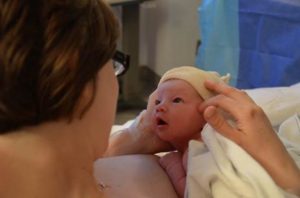Family Centered Caesarean and Caesarean Birth Choices
- a clear plastic drape or for the drape to be lowered to see the baby immediately after they are born
- that the birthing person’s arms are not strapped down to make it easier to touch and hold the baby
- the monitoring equipment be placed in a position to allow for skin to skin contact with the baby
- that the baby is delivered slowly to clear the lungs of fluid in a similar way to a vaginal birth
- delayed cord clamping
- that a long section of umbilical cord is left attached to the baby so the partner can still ‘cut the cord’
- the partner and baby stay in the operating room throughout the procedure, rather than leaving to wait in the recovery room during the final steps of the surgery
- the baby be placed on their parent skin to skin after birth. Skin to skin:
- Can help regulate the baby’s heart-rate, breathing and temperature
- Calms and relaxes both parent and baby
- Stimulates the release of hormones to support breast/chestfeeding
- Helps with breast/chestfeeding initiation

After a Caesarean Birth
It helps to know the following:
- There will be abdominal pain. Medication will be given for pain relief. The medication offered is safe to take while breast/chestfeeding, and decreasing the pain will aid in recovery
- Having a caesarean birth does not affect milk supply
- You can ask the nurse to help find breast/chestfeeding positions that won’t put pressure on the incision
- You will most likely start on a liquid diet and then move to solid food. You will have an IV in your arm until you are able to keep fluids down. You may have a catheter in place for a few hours to help pass urine.
- Some types of sutures (stitches) are absorbed. If the sutures are not this kind or if there are staples, the hospital nurse or public health nurse will remove them around 4 days after the birth.
Generally it takes about 4 to 6 weeks for the incision to heal completely, but some people feel well before this time. Until the incision is fully healed, it is important to:
- Take it easy: During recovery, avoid housework and lifting anything heavier than the baby. Do not lift the baby in the car seat. If possible, have everything to hand on the same level in the house to avoid going up and down stairs continuously
- Support the abdomen: Use good posture when standing and walking. It can help to hold the abdomen near the incision during sudden movements caused by coughing, sneezing or laughing and hold a pillow to the abdomen when standing up or moving in bed. When getting up from lying down, first roll onto the side and then push up to a sitting position
- Limit company for the first few weeks: Too many visitors will keep you from getting the rest you need to recover and care for your newborn. Accept help from people who will make meals, do laundry and tidy the home
- Rest: Try to take take daily naps for the first 3 to 4 weeks or longer

- Stay hydrated: You will likely need extra fluids to replace those lost in delivery and breast/chestfeeding. Emptying the bladder frequently can help reduce the risk of urinary tract infections.
- Avoid driving: Until you are able to deal with making sudden movements when driving in traffic, you should avoid driving. This could take up to 6 weeks. Your car insurance provider may also have restrictions with how coverage may be affected by surgery.
- Keep the incision clean: You should shower every day after the first 24-48 hours to keep the incision clean, unless your healthcare provider says otherwise. When cleaning and drying avoid scrubbing the incision site as this may pull on the staples or stitches. Try to pat dry with a towel instead. Showering rather than taking a bath is recommended until the incision is completely healed.
Emotions after a caesarean birth vary widely. Some new parents feel relief when it’s all over, yet may also feel a little disappointed. If you are upset or worried, talk with your healthcare provider, partner, or someone you trusts
Many women who have had a caesarean birth can have a vaginal birth with a later pregnancy (VBAC). This can be discussed with the woman’s healthcare before or during the next pregnancy.
Call 811 or your health care provider immediately if:
- there is increased oozing or blood coming from the incision
- there is yellow or green discharge coming from the incision
- the pain gets worse, or isn’t helped by the pain medicine
- the incision is opening up
- there are red, hot and tender areas around the incision
- there is a fever of more than 38 ºC
- legs have red, hot patches on them